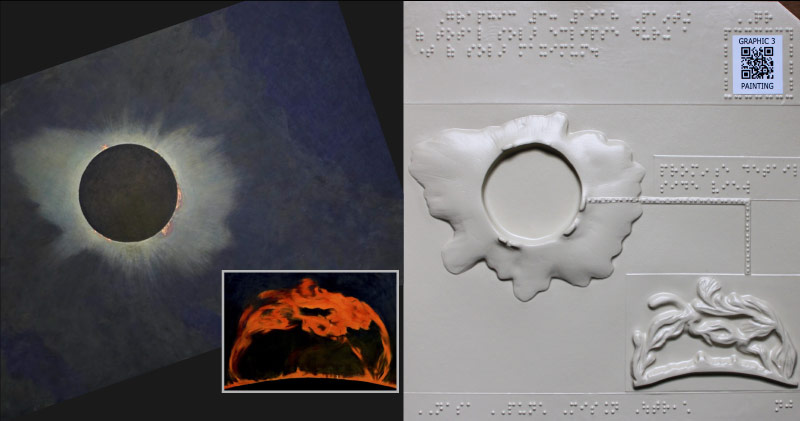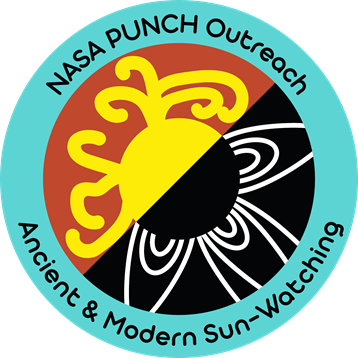Graphic 3: 1918 Painting of total solar eclipse near a time of solar maximum
Welcome to Tactile Graphic number 3 – the 1918 Painting! This is the third of seven images supporting the Petroglyph Inquiry.
Whether you are engaging fully with the Petroglyph Inquiry (recommended) or just browsing the PUNCH Outreach set of seven images in a random order, we strongly encourage you to begin by reading the 2-page section entitled Essential Background if you have not already done so.
Guided Description of the Tactile Graphic number 3

The tactile image between the Braille areas at the top and bottom of Graphic 3 represents a scientifically accurate oil painting made by an extraordinary man of many disciplines named Howard Russell Butler. The painting is based on his observations of the solar corona made from Baker City, Oregon during the total solar eclipse on June 8, 1918. Like the 1860 hand drawing in Graphic 2, this 1918 eclipse also occurred near a time of solar maximum.
Please pause to explore the tactile image, be sure to find the features listed below:
- A central circular disk representing the Sun eclipsed by the Moon
- Dense rays of the solar corona extending out in all directions from the central disk
- Small, raised features called solar prominences located very close around the central disk
- The guideline from a small solar prominence to a magnified prominence at the lower right with its dramatic curved and curled structure.
As you can tell, by comparison with the hand-drawing in Graphic 2, solar prominences are MUCH smaller than the rays, streamers, and storm structures of the corona. Even so, solar prominences are often perceived by human eyes during eclipse totality. They appear as small, bright pink blobs of light located around the circular disk. There are almost always some of them present during any phase of the solar activity cycle, whether or not the Sun is in a particularly stormy phase. However, during solar maximum prominences can become larger, more abundant, and more likely to erupt.
After observing the solar prominences available to him during totality through binoculars, Mr. Butler sketched and later painted some of them. Solar prominences hover in the Sun’s lower corona, but they generally do not leave the Sun unless the prominence erupts as part of a solar storm called a Coronal Mass Ejection (C-M-E) which can explode the solar material outward into space. Not all prominences are associated with such eruptions. Prominences can last from a few minutes to several months.
REFLECTION and DISCUSSION
Could solar prominences be related to interpreting the Chaco petroglyph?
Graphic 3: ADDITIONAL COMMENTARY for those doing the PETROGLYPH INQUIRY
These additional comments are intended to enrich and support your participation in the “petroglyph inquiry.” Please keep going with your list of strengths, weaknesses, ideas, and questions regarding the “1097 eclipse” hypothesis for interpreting the Chaco petroglyph (Graphic 1). How does Graphic 3 influence your thinking?
Could solar prominences be related to interpreting the Chaco petroglyph? Here are some points to consider:
- During the 1097 eclipse, could there have been solar prominences all around the Sun that somehow appeared larger and more striking at the time? Is it possible that the curlicue features of the Chaco petroglyph are representing an Ancestral Puebloan impression of solar prominences that are by nature loopier and curvier than the usual coronal rays?
- Maybe the curlicues of the petroglyph are not to scale, but an impression of the prominences the Chaco residents saw? If the smaller pecked disk to the upper left of the main curlicue petroglyph is Venus, this would not be an accurate scaling. If a proper scale were being represented Venus would have to be significantly farther from the main petroglyph. Thus, could the curlicue features of the petroglyph represent exaggerated likenesses of observed prominences that are not to scale when compared to the size of the disk?
- One of our Puebloan colleagues has reminded us that a petroglyph takes much longer to create than a hand drawing or a photograph and is entirely crafted from memory. He even suggested that a number of observers may have had a group conversation about what they remembered seeing and made a collaborative design in the sand for how their combination of impressions would be recorded as a rock carving.
REFLECTION and DISCUSSION
What do you think? What if you tried exploring something with your eyes or your hands for a few minutes and then were asked to create an impression of it as a drawing or a clay sculpture? How accurate do you think it would be? Could solar prominences be related to interpreting the Chaco petroglyph? Please add to your list of strengths, weaknesses, ideas, and questions regarding the “1097 eclipse” hypothesis for interpreting the Chaco petroglyph (Graphic 1).
When you are ready, click on the NEXT button below to go to graphics 4a and 4b, which are ground-based photographs of the solar corona, one at solar maximum, and the other at solar minimum.
